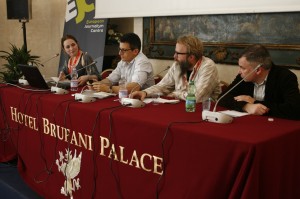The Dawn of Data Journalism
Data journalism is the most buzzworthy topic at the 2013 International Journalism Festival in Perugia, Italy. As an emerging field of new media, few people understand what it is, and how it differs from other forms of journalism. At the Excel for Journalists workshop, Professor Steve Doig, a Pulitzer Prize-winning data journalist and the Knight Chair in Journalism at Arizona State University, offered a succinct introduction to what journalists often call “computer-assisted reporting.”
Discovering Data
Data journalism is the journalistic process of shifting through publicly available data to uncover outliers — hidden patterns that could offer something fresh and fascinating about a societal issue. To work with big data, journalists need to be numerically literate and have an aptitude for data curation. Spreadsheet programs such as Microsoft Excel are often the default software that journalists utilize to import, sort, filter, transform, and summarize data. Once the data has been cleaned, one could then use visual software such as Photoshop or Google Fusion Tables to present the information in an interactive, engaging format.
The History of Data
Despite its Web 2.0 panache, data journalism first appeared in the 1960s when American journalists perused public records to uncover the disproportionate sentencing of racial minorities in the US justice system. In 1972, Philip Meyer’s “Precision Journalism: A Reporter’s Introduction to Social Science Methods”, became the bible that defined the use of social science research techniques in journalism. But it was Bill Dedman, an American investigative reporter, who revolutionized the use of data in investigative reporting. In 1989, Dedman combed through bank ledgers to uncover a pattern of racial discrimination by Atlanta-based mortgage lenders. He discovered that despite being similarly qualified, African-American applicants had to have twice the income as white applicants in order to get a loan of the same amount. Dedman earned the Pulitzer Prize for Investigative Reporting for his work, which was published as “The Color of Money” series.
In the 1980s, the introduction of personal computers such as Apple’s Macintosh and Atari 800 empowered other journalists to implement technology in their reporting. Doig, for example, was part of the Pulitzer-Prize winning investigative team that, in the aftermath of Hurricane Andrew in South Florida, discovered that weakened building codes contributed greatly to property damage.
Today, journalists around the world continue to use big data to crack stories on campaign finance, wealth disparities, crime patterns, demographic shifts, sports statistics, and auto accidents. For example, the USA Today exposed rampant cheating in the US public school system and the pitfalls of the No Child Left Behind Act. In the UK, the Guardian contributed to transparency in government spending by publishing what UK members of parliament claim in meals and travel expenses.
Accessing Data
Since big data is often subsidized by taxpayer’s money, the public must have unlimited access to the information. Legislation such as the Open Government Act (Wet Openbaarheid van Bestuur) has guaranteed the citizen’s right to government data in European countries. And, since the 1960s, the Freedom of Information Act (FOIA) has given the American public access to government information. Due to the largess of organizations such as the Open Knowledge Foundation (OKF), European Journalism Centre (EJC), National Institute of Computer-Assisted Report (NICAR) and Investigative Reporters & Editors, journalists and concerned citizens can develop new skills in computer-assisted reporting. In 2011, the Data Journalism Handbook, a compendium of tips and techniques from journalists, developers, and professors, was published after a 48 hour workshop at the MozFest in London.
Even though the news business is in a constant state of transition and turmoil, Doig says, “Data journalism is a low-investment research process that will help you discover a newsworthy story.”
Rama Musa
@RamaLeoa

